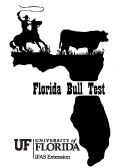 The North Florida Research and Education Center in Marianna, Florida annually hosts the Florida Bull Test. By controlling the environmental factors and taking Expected Progeny Differences (EPD’s) into account, the data clearly emphasizes the dual importance of genetics and environment in all cattle types. This 9-page fact sheet presents the procedures, rules, and results of the 2012-2013 test. Written by G. Cliff Lamb and Nicolas DiLorenzo, and published by the UF Department of Animal Sciences, October 2013.
The North Florida Research and Education Center in Marianna, Florida annually hosts the Florida Bull Test. By controlling the environmental factors and taking Expected Progeny Differences (EPD’s) into account, the data clearly emphasizes the dual importance of genetics and environment in all cattle types. This 9-page fact sheet presents the procedures, rules, and results of the 2012-2013 test. Written by G. Cliff Lamb and Nicolas DiLorenzo, and published by the UF Department of Animal Sciences, October 2013.
http://edis.ifas.ufl.edu/an290
Category: Livestock
Equine Lameness and Imaging Service series
The veterinarians of the University of Florida Equine Lameness & Imaging Service specialize in the treatment and rehabilitation of poor performance in sport horses. This series of one-page full color fact sheets describes various diagnostic and imaging services available for diagnosing and treating lameness issues in horses. Computed Tomography (CT) for the Horse
Digital Ultrasonography for the Horse
Extracorporeal Shockwave Therapy for the Horse
Lameness Locator™ for the Horse
Magnetic Resonance Imaging (MRI) for the Horse
Nuclear Scintigraphy (Bone Scan) for the Horse
http://edis.ifas.ufl.edu/topic_series_equine_lameness_and_imaging_service
Comparing Waterbeds and Sand Beds for Cows: A Study at the UF/IFAS Dairy Unit (VM194)
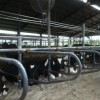 One important aspect of a cow’s comfort is the type of bedding used. Waterbeds for cows have recently gained popularity because of advertisements, news reports in outlets such as CNN. The UF/IFAS Dairy Unit (DU) provides a good opportunity to compare sand beds and waterbeds at optimal conditions. The dairy has waterbeds installed in one half of the barns and sand beds in the other half. This publication provides a field comparison of waterbeds and sand beds in one herd. We observed that when stalls are maintained at optimal conditions, cows in sand-bedded stalls had decreased incidence of hock lesions and increased stall usage compared to cows in waterbeds. This 5-page fact sheet was written by Klibs N. Galvão and Ori Eizenberg, and published by the UF Department of Veterinary Medicine-Large Animal Clinical Sciences, May 2013.
One important aspect of a cow’s comfort is the type of bedding used. Waterbeds for cows have recently gained popularity because of advertisements, news reports in outlets such as CNN. The UF/IFAS Dairy Unit (DU) provides a good opportunity to compare sand beds and waterbeds at optimal conditions. The dairy has waterbeds installed in one half of the barns and sand beds in the other half. This publication provides a field comparison of waterbeds and sand beds in one herd. We observed that when stalls are maintained at optimal conditions, cows in sand-bedded stalls had decreased incidence of hock lesions and increased stall usage compared to cows in waterbeds. This 5-page fact sheet was written by Klibs N. Galvão and Ori Eizenberg, and published by the UF Department of Veterinary Medicine-Large Animal Clinical Sciences, May 2013.
http://edis.ifas.ufl.edu/vm194
Wildland Weeds: Paragrass, Urochloa mutica (SSAGR370/AG375)
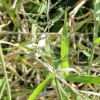 Paragrass (also referred to as Californiagrass) is thought to have been introduced into Florida sometime in the late 1870s as a forage plant. The semiaquatic grass is a native of tropical Africa, and today it is established in both hemispheres in tropical and subtropical regions as a highly palatable fodder. The grass is established in regions of poorly drained soils and along freshwater shorelines in Alabama, Florida, Hawaii, Maryland, Oregon, South Carolina, and Texas. It is an extremely aggressive competitor that can displace many shoreline emergent plants and plants in cultivated or disturbed sites associated with moist soil. Paragrass becomes readily established in wet soils along shorelines where it can form large monocultures. This 4-page fact sheet was written by L. T. Markle, B. A. Sellers, and W. A. Overholt, and published by the UF Department of Agronomy, April 2013.
Paragrass (also referred to as Californiagrass) is thought to have been introduced into Florida sometime in the late 1870s as a forage plant. The semiaquatic grass is a native of tropical Africa, and today it is established in both hemispheres in tropical and subtropical regions as a highly palatable fodder. The grass is established in regions of poorly drained soils and along freshwater shorelines in Alabama, Florida, Hawaii, Maryland, Oregon, South Carolina, and Texas. It is an extremely aggressive competitor that can displace many shoreline emergent plants and plants in cultivated or disturbed sites associated with moist soil. Paragrass becomes readily established in wet soils along shorelines where it can form large monocultures. This 4-page fact sheet was written by L. T. Markle, B. A. Sellers, and W. A. Overholt, and published by the UF Department of Agronomy, April 2013.
http://edis.ifas.ufl.edu/ag375
Cattle Grub Management (ENY290/IN979)
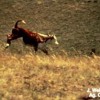 Immature warble flies, or cattle grubs, infest and harm livestock throughout the world. Warble flies also are known as “heel flies” because they cause cattle to kick at themselves, and “gad flies” because they cause cattle to “gad about” in an attempt to evade the flies. Two species of cattle grubs occur in the U.S.A., the common cattle grub, and the northern cattle grub. This 6-page fact sheet was written by P. E. Kaufman and E. N. I. Weeks, and published by the UF Department of Entomology and Nematology, March 2013.
Immature warble flies, or cattle grubs, infest and harm livestock throughout the world. Warble flies also are known as “heel flies” because they cause cattle to kick at themselves, and “gad flies” because they cause cattle to “gad about” in an attempt to evade the flies. Two species of cattle grubs occur in the U.S.A., the common cattle grub, and the northern cattle grub. This 6-page fact sheet was written by P. E. Kaufman and E. N. I. Weeks, and published by the UF Department of Entomology and Nematology, March 2013.
http://edis.ifas.ufl.edu/in979
Pest Management Perceptions and Practices for Equine Farms in North and Central Florida (ENY2028/IN983)
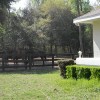 Equine facilities have unique pest management problems due to facility structure and horse husbandry practices. In Florida, homes on small equine farms are generally located in close proximity to pastures, stalls or run-in sheds, manure piles, and other fly breeding habitats. So homeowners have a high risk of exposure to pathogens that can be transmitted by filth flies to humans. Integrated pest management for equine farms requires accurate diagnosis of pest problems and the coordinated use of science-based management practices, but a recent survey shows that many equine property owners don’t know enough about the identification, biology, and presence of filth fly pests on their properties to develop successful IPM programs. This 7-page fact sheet was written by Erika T. Machtinger, Norman C. Leppla, and Cindy Saunders, and published by the UF Department of Entomology and Nematology, March 2013.
Equine facilities have unique pest management problems due to facility structure and horse husbandry practices. In Florida, homes on small equine farms are generally located in close proximity to pastures, stalls or run-in sheds, manure piles, and other fly breeding habitats. So homeowners have a high risk of exposure to pathogens that can be transmitted by filth flies to humans. Integrated pest management for equine farms requires accurate diagnosis of pest problems and the coordinated use of science-based management practices, but a recent survey shows that many equine property owners don’t know enough about the identification, biology, and presence of filth fly pests on their properties to develop successful IPM programs. This 7-page fact sheet was written by Erika T. Machtinger, Norman C. Leppla, and Cindy Saunders, and published by the UF Department of Entomology and Nematology, March 2013.
http://edis.ifas.ufl.edu/in983
Understanding the Effects of Forage Composition and Structure in Ruminant Nutrition (AN288)
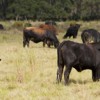 Approximately 68% of the 16 million square miles of agricultural land worldwide is used for permanent pastures for livestock production. Fortunately, ruminants can convert plant matter that is inedible or of low nutritional value for monogastrics (i.e., swine or poultry) into calorically dense products of high nutritional value. However, the process of converting poor quality plant matter into useful nutrients for ruminants is complex. This 3-page fact sheet provides an overview and understanding of how forage composition and structure affect the nutritive value and nutrient availability to ruminants. Written by Kalyn M. Waters, Nicolas DiLorenzo, and G. Cliff Lamb, and published by the UF Department of Animal Sciences, March 2013.
Approximately 68% of the 16 million square miles of agricultural land worldwide is used for permanent pastures for livestock production. Fortunately, ruminants can convert plant matter that is inedible or of low nutritional value for monogastrics (i.e., swine or poultry) into calorically dense products of high nutritional value. However, the process of converting poor quality plant matter into useful nutrients for ruminants is complex. This 3-page fact sheet provides an overview and understanding of how forage composition and structure affect the nutritive value and nutrient availability to ruminants. Written by Kalyn M. Waters, Nicolas DiLorenzo, and G. Cliff Lamb, and published by the UF Department of Animal Sciences, March 2013.
http://edis.ifas.ufl.edu/an288
Effect of Age at Castration on Beef Calf Performance (AN289)
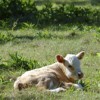 A study in Florida was conducted to examine the issue of age at castration to determine if castration timing resulted in significant differences in growth rate and weaning weight in nursing calves. In addition, the study included a comparison between Angus and Brangus calves in the treatment groups to determine if there was a breed by castration effect. No differences in calf growth rates were observed in early compared to late castration. This 4-page fact sheet was written by Amie Imler, Todd Thrift, Matt Hersom, and Joel Yelich, and published by the UF Department of Animal Sciences, March 2013.
A study in Florida was conducted to examine the issue of age at castration to determine if castration timing resulted in significant differences in growth rate and weaning weight in nursing calves. In addition, the study included a comparison between Angus and Brangus calves in the treatment groups to determine if there was a breed by castration effect. No differences in calf growth rates were observed in early compared to late castration. This 4-page fact sheet was written by Amie Imler, Todd Thrift, Matt Hersom, and Joel Yelich, and published by the UF Department of Animal Sciences, March 2013.
http://edis.ifas.ufl.edu/an289
Forced-Use Dust Bags for Management of External Parasites (ENY281/IG135)
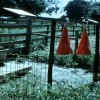 Dust bags are an effective method of horn fly and louse control. However, dust bags are only effective when hung in places where cattle are forced to use them. The best locations are areas where cattle must pass once or twice a day, or every other day, for instance between mineral boxes or water and pasture. During the field tests, forced-use dust bags provided an average of 90% horn fly control. Production was increased by an average of 34% over the normal management practice. This increase in production was equivalent to 1/3 lb/animal/day. This 5-page fact sheet was written by P. E. Kaufman and E. N. I. Weeks, and published by the UF Department of Entomology and Nematology, November 2012.
Dust bags are an effective method of horn fly and louse control. However, dust bags are only effective when hung in places where cattle are forced to use them. The best locations are areas where cattle must pass once or twice a day, or every other day, for instance between mineral boxes or water and pasture. During the field tests, forced-use dust bags provided an average of 90% horn fly control. Production was increased by an average of 34% over the normal management practice. This increase in production was equivalent to 1/3 lb/animal/day. This 5-page fact sheet was written by P. E. Kaufman and E. N. I. Weeks, and published by the UF Department of Entomology and Nematology, November 2012.
http://edis.ifas.ufl.edu/ig135
Florida Dairy Industry Statistics: Economic Measures (AN287)
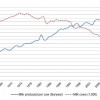 This 7-page fact sheet brings together key economic and price data about Florida’s primary dairy industry collected by the U.S. Department of Agriculture (USDA). Written by K.G. Arriola and A. De Vries, and published by the UF Department of Animal Sciences, February 2013.
This 7-page fact sheet brings together key economic and price data about Florida’s primary dairy industry collected by the U.S. Department of Agriculture (USDA). Written by K.G. Arriola and A. De Vries, and published by the UF Department of Animal Sciences, February 2013.
http://edis.ifas.ufl.edu/an287
Florida Dairy Industry Statistics: Herd Performance Measures and Benchmarks (AN286)
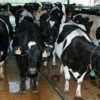 This 8-page fact sheet summarizes technical performance data of dairy herds in Florida and the Southeast United States collected through the Dairy Herd Improvement (DHI) program. Written by K.G. Arriola and A. De Vries, and published by the UF Department of Animal Sciences, February 2013.
This 8-page fact sheet summarizes technical performance data of dairy herds in Florida and the Southeast United States collected through the Dairy Herd Improvement (DHI) program. Written by K.G. Arriola and A. De Vries, and published by the UF Department of Animal Sciences, February 2013.
http://edis.ifas.ufl.edu/an286
Tropical Soda Apple Leaf Beetle, Gratiana boliviana Spaeth (Insecta: Coleoptera: Chrysomelidae: Cassidinae) (EENY543/IN974)
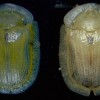 Tropical soda apple is a prickly shrub native to South America that is a major problem in pastures and conservation areas. So a multi-agency program supported the rearing, distribution, and release of more than 250,000 tropical soda apple leaf beetles across Florida from 2003 to 2011. This 4-page fact sheet was written by Rodrigo Diaz, William A. Overholt, Ken Hibbard, and Julio Medal, and published by the UF Department of Entomology and Nematology, January 2013.
Tropical soda apple is a prickly shrub native to South America that is a major problem in pastures and conservation areas. So a multi-agency program supported the rearing, distribution, and release of more than 250,000 tropical soda apple leaf beetles across Florida from 2003 to 2011. This 4-page fact sheet was written by Rodrigo Diaz, William A. Overholt, Ken Hibbard, and Julio Medal, and published by the UF Department of Entomology and Nematology, January 2013.
http://edis.ifas.ufl.edu/in974
Tips for Integrating Land and Wildlife Management: Deer in Ranchlands (WEC330/UW375)
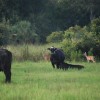 In addition to having generally low-quality foods, ranchlands often have a low diversity of food sources, further reducing the quality of habitat for deer. Ranchland management for deer should therefore focus on providing a diversity of abundant, high-quality foods. This 2-page fact sheet provides some deer habitat improvement tips that focus primarily on raising the quality of deer forage but that also will help you grow better cover by improving plant diversity and productivity. Written by William M. Giuliano, John M. Olson, and Cailey Thomas, and published by the UF Department of Wildlife Ecology and Conservation, January 2013.
In addition to having generally low-quality foods, ranchlands often have a low diversity of food sources, further reducing the quality of habitat for deer. Ranchland management for deer should therefore focus on providing a diversity of abundant, high-quality foods. This 2-page fact sheet provides some deer habitat improvement tips that focus primarily on raising the quality of deer forage but that also will help you grow better cover by improving plant diversity and productivity. Written by William M. Giuliano, John M. Olson, and Cailey Thomas, and published by the UF Department of Wildlife Ecology and Conservation, January 2013.
http://edis.ifas.ufl.edu/uw375
Nutrient Cycling in Grazed Pastures (SL376/SS578)
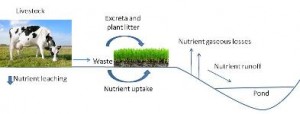 Many forage-based livestock production systems in Florida are characterized by extensive grazing with minimal inputs of commercial fertilizer and supplemental feed. In these systems, adequate soil fertility conditions are essential to sustain forage production. If nutrients become deficient, pasture and animal performance is reduced, and the economic returns of livestock operations may decline. This 3-page fact sheet discusses the different nutrient pathways in grazing pastures to help producers better understand how to promote nutrient cycling and pasture sustainability. Written by Maria L. Silveira, Joao M. B. Vendramini, Hiran M. da Silva, and Mariana Azenha, and published by the UF Department of Soil and Water Science, January 2013.
Many forage-based livestock production systems in Florida are characterized by extensive grazing with minimal inputs of commercial fertilizer and supplemental feed. In these systems, adequate soil fertility conditions are essential to sustain forage production. If nutrients become deficient, pasture and animal performance is reduced, and the economic returns of livestock operations may decline. This 3-page fact sheet discusses the different nutrient pathways in grazing pastures to help producers better understand how to promote nutrient cycling and pasture sustainability. Written by Maria L. Silveira, Joao M. B. Vendramini, Hiran M. da Silva, and Mariana Azenha, and published by the UF Department of Soil and Water Science, January 2013.
http://edis.ifas.ufl.edu/ss578
Tips for Integrating Land and Wildlife Management: Quail in Cattle Country (WEC332/UW377)
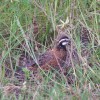 This 2-page fact sheet provides specific tips to improve quail habitat in cattle country that focus on diversifying the plant species and structural composition and increasing early successional communities dominated by herbaceous plants. Written by William M. Giuliano and Lauren Watine, and published by the UF Department of Wildlife Ecology and Conservation, January 2013.
This 2-page fact sheet provides specific tips to improve quail habitat in cattle country that focus on diversifying the plant species and structural composition and increasing early successional communities dominated by herbaceous plants. Written by William M. Giuliano and Lauren Watine, and published by the UF Department of Wildlife Ecology and Conservation, January 2013.
http://edis.ifas.ufl.edu/uw377
Pesticide Safety Around Animals (ENY272/IG128)
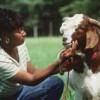 In general, infested animals are unhealthy and cannot be managed efficiently, so pesticides are commonly used to protect animals from pests. The successful control of pests requires careful mixing and application of recommended pesticides according to label directions. Besides ensuring the control of pests, applying pesticides at the recommended rate is necessary to prevent injury to the animal. This 5-page fact sheet was written by P. E. Kaufman and E. N. I. Weeks, and published by the UF Department of Entomology and Nematology, October 2012.
In general, infested animals are unhealthy and cannot be managed efficiently, so pesticides are commonly used to protect animals from pests. The successful control of pests requires careful mixing and application of recommended pesticides according to label directions. Besides ensuring the control of pests, applying pesticides at the recommended rate is necessary to prevent injury to the animal. This 5-page fact sheet was written by P. E. Kaufman and E. N. I. Weeks, and published by the UF Department of Entomology and Nematology, October 2012.
http://edis.ifas.ufl.edu/ig128
Classical Biological Control of Tropical Soda Apple with Gratiana boliviana (ENY865/IN971)
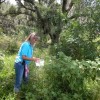 Tropical soda apple is a prickly shrub native to South America. First reported in Glades Co., Florida in 1988, it later spread to Georgia, Alabama, Louisiana, Texas, Mississippi, Tennessee, North Carolina, and South Carolina. It is a major problem in pastures and conservation areas. Negative impacts of tropical soda apple include reduction of cattle stocking rates, competition with native plants, and the costs associated with its control. Dense thickets of the weed also can disrupt the movement of wildlife. This 4-page fact sheet provides a summary of the major steps of the successful biological control program against tropical soda apple in Florida. The article covers the importance of the weed, identification and biology of the biological control agent, rearing and release efforts, establishment and impact, and efforts to communicate the outcomes of the program to stakeholders. Written by R. Diaz, J. Medal, K. Hibbard, A. Roda, A. Fox, S. Hight, P. Stansly, B. Sellers, J. Cuda and W. A. Overholt, and published by the UF Department of Entomology and Nematology, November 2012.
Tropical soda apple is a prickly shrub native to South America. First reported in Glades Co., Florida in 1988, it later spread to Georgia, Alabama, Louisiana, Texas, Mississippi, Tennessee, North Carolina, and South Carolina. It is a major problem in pastures and conservation areas. Negative impacts of tropical soda apple include reduction of cattle stocking rates, competition with native plants, and the costs associated with its control. Dense thickets of the weed also can disrupt the movement of wildlife. This 4-page fact sheet provides a summary of the major steps of the successful biological control program against tropical soda apple in Florida. The article covers the importance of the weed, identification and biology of the biological control agent, rearing and release efforts, establishment and impact, and efforts to communicate the outcomes of the program to stakeholders. Written by R. Diaz, J. Medal, K. Hibbard, A. Roda, A. Fox, S. Hight, P. Stansly, B. Sellers, J. Cuda and W. A. Overholt, and published by the UF Department of Entomology and Nematology, November 2012.
http://edis.ifas.ufl.edu/in971
Identification and Control of Southern Sandbur (Cenchrus echinatus L.) in Hayfields (SSAGR364/AG373)
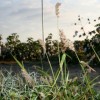 Southern sandbur is an annual grass that grows in pastures and cropland throughout the warm areas of the southern United States from Virginia to California. This native grass is adapted to dry, sandy soils and has a shallow, fibrous root system. It can easily invade a poorly managed field, diminishing the quality of a hay crop or grazing pasture. Southern sandbur seeds start to germinate in late spring, and germination continues through the summer and fall. Flowering occurs in late fall, and growth is consistent until the first frost. This 2-page fact sheet was written by Hunter Smith, Jason Ferrell, and Brent Sellers, and published by the UF Department of Agronomy, December 2012.
Southern sandbur is an annual grass that grows in pastures and cropland throughout the warm areas of the southern United States from Virginia to California. This native grass is adapted to dry, sandy soils and has a shallow, fibrous root system. It can easily invade a poorly managed field, diminishing the quality of a hay crop or grazing pasture. Southern sandbur seeds start to germinate in late spring, and germination continues through the summer and fall. Flowering occurs in late fall, and growth is consistent until the first frost. This 2-page fact sheet was written by Hunter Smith, Jason Ferrell, and Brent Sellers, and published by the UF Department of Agronomy, December 2012.
http://edis.ifas.ufl.edu/ag373
The Florida Bull Test 2011-2012 (AN284)
 The North Florida Research and Education Center in Marianna, Florida annually hosts the Florida Bull Test. By controlling the environmental factors and taking Expected Progeny Differences (EPD’s) into account, the data clearly emphasizes the dual importance of genetics and environment in all cattle types. This 5-page fact sheet presents the procedures, rules, and results of the 2011-2012 test. Written by G. Cliff Lamb and Nicolas DiLorenzo, and published by the UF Department of Animal Sciences, December 2012.
The North Florida Research and Education Center in Marianna, Florida annually hosts the Florida Bull Test. By controlling the environmental factors and taking Expected Progeny Differences (EPD’s) into account, the data clearly emphasizes the dual importance of genetics and environment in all cattle types. This 5-page fact sheet presents the procedures, rules, and results of the 2011-2012 test. Written by G. Cliff Lamb and Nicolas DiLorenzo, and published by the UF Department of Animal Sciences, December 2012.
http://edis.ifas.ufl.edu/an284
Application of Ionophores in Cattle Diets (AN285)
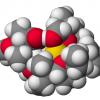 Beef cattle producers should consider using ionophores to increase calf gain and gain efficiency in a cost-effective manner. Ionophores are feed additives used in cattle diets to increase feed efficiency and body weight gain. They are compounds that alter rumen fermentation patterns. Ionophores can be fed to any class of cattle and can be used in any segment of the beef cattle industry. Similar to many other feed additives, ionophores are fed in very small amounts and supplied via another feedstuff as carrier for intake. Ionophores decrease incidence of coccidiosis, bloat, and acidosis in cattle. This 4-page fact sheet was written by Matt Hersom and Todd Thrift, and published by the UF Department of Animal Sciences, December 2012.
Beef cattle producers should consider using ionophores to increase calf gain and gain efficiency in a cost-effective manner. Ionophores are feed additives used in cattle diets to increase feed efficiency and body weight gain. They are compounds that alter rumen fermentation patterns. Ionophores can be fed to any class of cattle and can be used in any segment of the beef cattle industry. Similar to many other feed additives, ionophores are fed in very small amounts and supplied via another feedstuff as carrier for intake. Ionophores decrease incidence of coccidiosis, bloat, and acidosis in cattle. This 4-page fact sheet was written by Matt Hersom and Todd Thrift, and published by the UF Department of Animal Sciences, December 2012.
http://edis.ifas.ufl.edu/an285